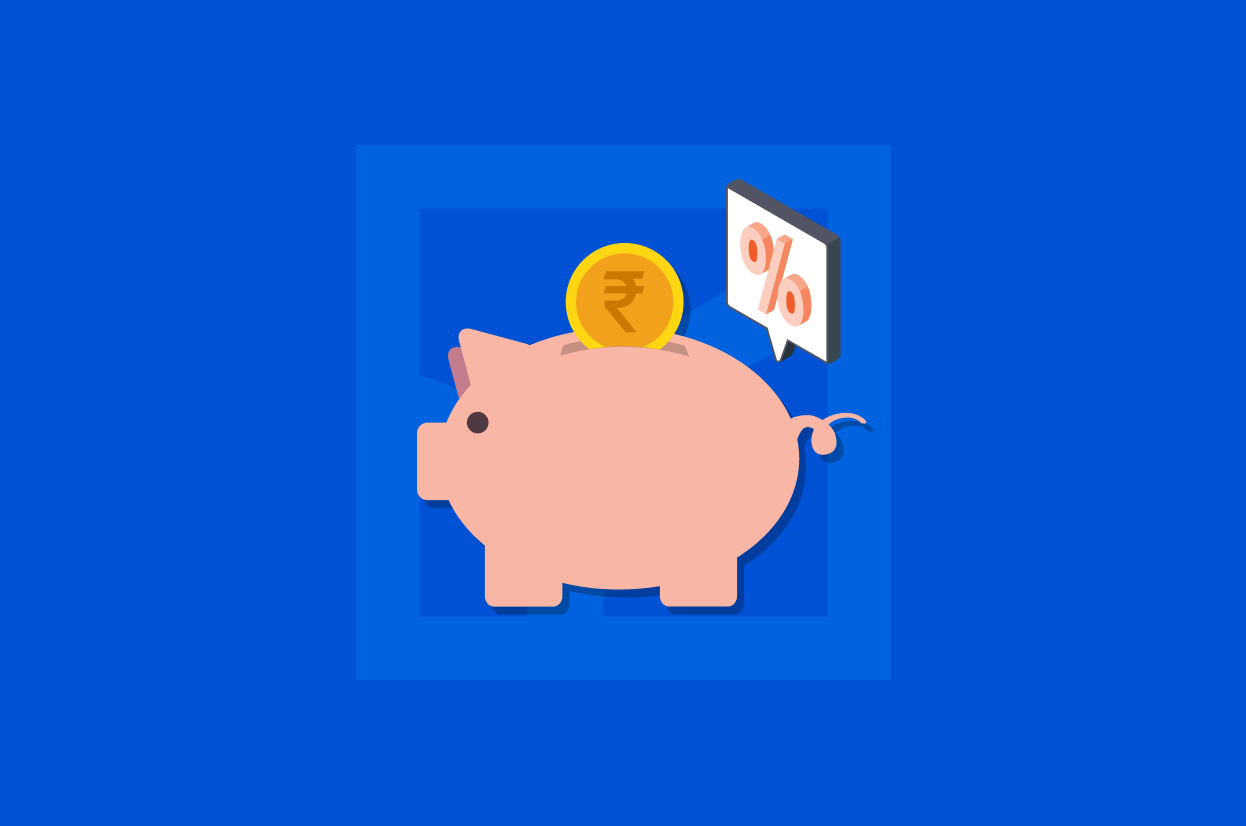Introduction
Despite having so many new investment options available in the market, fixed deposits (FD) are still a popular choice among investors. Even investors who majorly invest in equities for high returns invest in FDs for diversification. This is primarily because they offer fixed returns in the form of interest and ensure the capital is safe. The interest rate on FDs differs across banks and tenures and is paid either regularly or at the time of maturity. Let’s look at the interest rates on fixed deposits of various banks in India and understand how FD interest is calculated and taxed.
Highest FD Interest Rates of Public and Private Sector Banks in India 2024
| Name of the Bank | FD Interest Rate for Regular Citizens | FD Interest Rate for Senior Citizens |
| RBL Bank FD Rates | 3.5%-8% | 4%-8.5% |
| IndusInd Bank FD Rates | 3.5%-7.85% | 4.25%-8.25% |
| Bandhan Bank FD Rates | 3%-7.85% | 3.75%-8.35% |
| Yes Bank FD Rates | 3.25%-7.75% | 3.75%-8.25% |
| Karur Vysya Bank FD Rates | 4%-7.5% | 4%-8% |
| IDFC Bank FD Rates | 2.5%-7.5% | 3.5%-8.25% |
| DBS Bank FD Rates | 2.5%-7.5% | 2.5%-8% |
| Axis Bank FD Rates | 3%-7.1% | 3.5%-7.75% |
| HDFC FD Rates | 3%-7.2% | 3.5%-7.75% |
*Interest rates as of January 2024
FD Interest Rates of Small Finance Banks in India 2024
| Name of the Bank | FD Interest Rate for Regular Citizens | FD Interest Rate for Senior Citizens |
| Unity Small Finance Bank FD Rates | 4.5%-9% | 4.5%-9.5% |
| Suryoday Small Finance Bank FD Rates | 4%-8.6% | 4.5%-9.5% |
| Utkarsh Small Finance Bank FD Rates | 4%-8.5% | 4.6%-9.1% |
| Ujjivan Small Finance Bank FD Rates | 3.75%-8.25% | 4.25%-8.75% |
| AU Small Finance Bank FD Rates | 3.75%-8% | 4.25%-8.5% |
*Interest rates as of January 2024
FD Interest Rates of NBFCs in India 2024
| Name of the NBFC | FD Interest Rate for Regular Citizens | FD Interest Rate for Senior Citizens |
| Bajaj Finserv FD | 7.4% – 8.35% | 7.65%-8.6% |
| Shriram Finance FD | 7.34%-8.18% | 7.84%-8.68% |
| Sundaram Finance FD | 7.45%-7.75% | 7.95%-8.25% |
| Mahindra & Mahindra Finance Service Ltd FD | 7.4%-7.75% | 7.65%-7.95% |
*Interest rates as of January 2024
How is FD Interest Calculated?
Banks use two methods to calculate interest on fixed deposits. One is the simple interest method, and the other is the compound interest method. Depending on the tenure and the amount of deposit, banks select the method of interest calculation.
Simple Interest Method
In the simple interest method, you earn interest only on the principal amount. The formula for the simple interest method is given below.
Simple Interest = Principal * rate * time period/100
If you invest Rs 50,000 in a FD for 3 years at an interest of 5%, then the interest will be calculated as below.
Interest = 50,000*5%*3/100
Interest = Rs 7,500
The total interest that you will earn in 3 years is Rs 7,500.
Compound Interest Method
In the compound interest method, you earn the interest on the principal as well as the interest. Every year, the interest you earn is added back to the principal, and the interest is calculated on the new principal. The majority of the banks offer compound interest to FD investors. Compound interest is calculated using the formula given below.
Compound Interest = P * [(1+i)^n]-1
Where,
- P is the principal amount
- i is the rate of interest
- n is the number of years
In the above example, if the interest is compounded annually, then the compound interest will be calculated as follows.
Compound interest = 50,000 * [(1+.05) ^3]-1
Compound Interest = Rs 7,881.25
How is FD Interest Taxed?
Under the Income Tax Act 1961, interest accrued on FDs is categorized as ‘income from other sources’ and is thus subject to taxation as per your applicable income tax slab rate. This interest is added to your gross annual income, and taxes are computed according to prevailing tax regulations.
Tax Deducted at Source (TDS) on FD Interest
If the interest earned on FDs exceeds Rs 40,000 (Rs 50,000 for senior citizens), TDS at 10% is deducted as per the Income Tax Act, 1961. In case no PAN is available, the TDS is deducted at 20% of the interest earned.
To claim tax exemption, you must submit Form 15H or 15G (depending on age and income) to the bank at the beginning of the financial year.
If TDS is deducted before submitting these forms, you can file for an Income Tax Return (ITR). Alternatively, you can opt for tax-saving FDs with a 5-year lock-in period and claim deductions under Section 80C of the Income Tax Act to avoid tax. Investments up to Rs 1,50,000 are eligible for this tax deduction.
Things to Keep in Mind Before Investing in FD
Before investing in an FD, it’s important to consider the following factors to ensure you make an informed decision:
- Interest Rates: Compare the interest rates offered by different banks or financial institutions. Higher interest rates typically mean higher returns on your investment.
- Tenure: Choose the tenure of the FD that suits your financial goals. FDs are available for various durations, ranging from a few days to several years. Choose a tenure based on your liquidity needs and investment horizon.
- Penalty for Premature Withdrawal: Understand the penalty implications if you need to withdraw your FD prematurely (before the maturity date). Some banks may charge a penalty or offer reduced interest rates for premature withdrawals.
- Taxation: Consider the tax implications of the interest earned on your FD. The interest earned on FDs is taxable as per the your tax slab. Make sure to calculate the post-tax returns on your investment.
- Safety and Reputation of the Institution: Invest in FDs offered by reputed banks that are regulated by the RBI or financial institutions with a strong track record of reliability and stability. Check credit ratings and customer reviews to assess the institution’s credibility.
- Automatic Renewal: Some banks automatically renew FDs upon maturity unless instructed otherwise. Be aware of this feature and decide whether you want your FD to be renewed or redeemed upon maturity.
- Investment Goals: Determine your investment goals and assess whether FDs align with them. FDs can be a suitable option if you’re seeking steady returns with low risk and don’t require immediate liquidity.
- Inflation Rate: Consider the prevailing inflation rate while evaluating FDs. Ensure that the interest rate offered on the FD is sufficiently higher than the inflation rate to maintain the purchasing power of your investment.
- Liquidity Needs: Assess your liquidity requirements before investing in an FD. While FDs offer fixed returns, they lack liquidity compared to other investment options like mutual funds.
- Terms and Conditions: Carefully read the terms and conditions of the FD scheme, including any clauses related to premature withdrawal, renewal, nomination facility, and documentation requirements.
By considering these factors, you can make a well-informed decision when investing in a fixed deposit.
Conclusion
If you are planning to invest in an FD, first list your financial goals and decide your investment horizon. Once you decide on a horizon, you must check and compare the fixed deposit interest rates of various banks. The interest rates across banks vary by a small margin, but even a 1% difference can be a lot when you invest a huge sum of money.
Frequently Asked Questions (FAQs)
Can I get monthly interest on my Fixed Deposit (FD)?
Yes, you can opt for monthly interest payouts on your FDs.
What is the interest rate applicable for Fixed Deposits (FD)?
The interest rate on a fixed deposit depends on the tenure, bank, and age. Senior citizen depositors have preferential interest rates that are 0.25% to 0.5% higher than the regular deposit rates. Currently, the fixed deposit interest rates range from 2.5% to 9% per annum.
What is the minimum tenure for an Fixed Deposits (FD) account?
The minimum deposit tenure may vary from bank to bank, and it usually can be between 7 days and 1 year.
What is the minimum deposit amount to open an Fixed Deposits (FD) account?
The minimum deposit amount may vary from bank to bank; it can range between Rs 1,000 and Rs 10,000.
What are Form 15G and 15H?
Form 15G and Form 15H are forms for customers to prevent TDS deduction from their interest income, provided they meet the necessary criteria. Additionally, having a PAN card is a prerequisite for availing tax exemption via Forms 15G and 15H.
When is TDS deducted?
If your FD interest income is more than Rs 40,000 in a financial year, the bank deducts TDS at a rate of 10%. And, for senior citizens the threshold limit is Rs 50,000. And, in case you do not furnish your PAN card, the applicable TDS rate is 20%.
Is it compulsory to submit a PAN to open an Fixed Deposits (FD)?
Yes, it is compulsory to submit your PAN when applying for a fixed deposit. However, in case you do not have a PAN card, you can submit Form 60/61.







